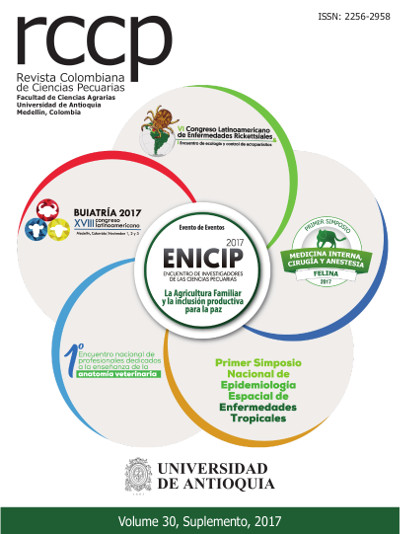A look at the veterinary practitioner's changing role and One Health
DOI:
https://doi.org/10.17533/udea.rccp.330578Abstract
This presentation will focus on veterinary medicine in the area of dairy herd health and the concept of One Health. I will first examine how the practice has evolved over time using a model proposed by the late Dr. Calvin Schwabe. I will also examine the current role of the bovine practitioner in ensuring herd health, especially regarding the collection of data for use in decision-making. Finally, I will look at what the future holds for the veterinarian in dairy practice. In general, the practice of veterinary medicine has evolved at different rates in different parts of the world. The tools used by veterinarians and the solutions proposed for medical issues also vary depending on the species and type of animal production. A variety of factors —historic, geopolitical, economic, and social— come together to determine the role of the veterinarian in any given country. The history and evolution of veterinary medicine have been the subject of numerous articles and books, many of which have focused on its relationship to human medicine and civilization. One thinker and researcher who has contributed greatly to our understanding of the evolution of preventive veterinary medicine is Calvin Schwabe. His ideas contributed to the concept of One Health. Dr. Schwabe was a veterinarian and professor at the University of California, where he founded the Department of Epidemiology and Preventive Medicine, now the Department of Medicine and Epidemiology.
Downloads
References
American Veterinary Medical Association (AVMA) . Veterinary specialists: URL: www.avma.org/public/YourVet/Pages/veterinary-specialists.aspx
Bates AJ, Dohoo I. Risk factors for peri-parturient farmer diagnosed mastitis in New Zealand dairy herds: Findings from a retrospective cohort study. Prev Vet Med 2016; 127:70-76.
Bouchard E . Portrait québécois de la reproduction . Symposium sur les bovins laitiers . Centre de Référence en Agriculture et Agroalimentaire du Québec (CRAAQ). St-Hyacinthe: 1-12. 2003. URL : https://www.agrireseau.net/bovinslaitiers/Documents/Bouchard_Emile.pdf
Boyd D, Crawford K. Critical questions for big data. Information, Communication & Society 2012; 15:662-679.
Ida S. Two ways of knowing: big data and evidence-based medicine. Annals Intern Med 2016. 164(8):562-564.
News and Reports. Informatics: Making the most of ‘big data’ in veterinary practice and research. Vet Rec 2016; 178:385-386.
Nolen, SR . Legends: The accidental epidemiologist. Dr. Calvin W. Schwabe fathered a generation of veterinary epidemiologists. JAVMA news. July 2013. URL: https://www.avma.org/News/JAVMANews/Pages/130701m.aspx
Schwabe, CW. The current epidemiological revolution in veterinary medicine. Part I. Prev Vet Med 1982; 1:5-15.
Schwabe, CW. Veterinary Medicine and Human Health, 3rd ed .Williams & Wilkins: Baltimore, 1984, xix, pp 1–680.
Schwabe, CW. The current epidemiological revolution in veterinary medicine. Part II. Prev Vet Med 1993; 18(1):3-16.
Downloads
Published
How to Cite
Issue
Section
License
The authors enable RCCP to reprint the material published in it.
The journal allows the author(s) to hold the copyright without restrictions, and will allow the author(s) to retain publishing rights without restrictions.






